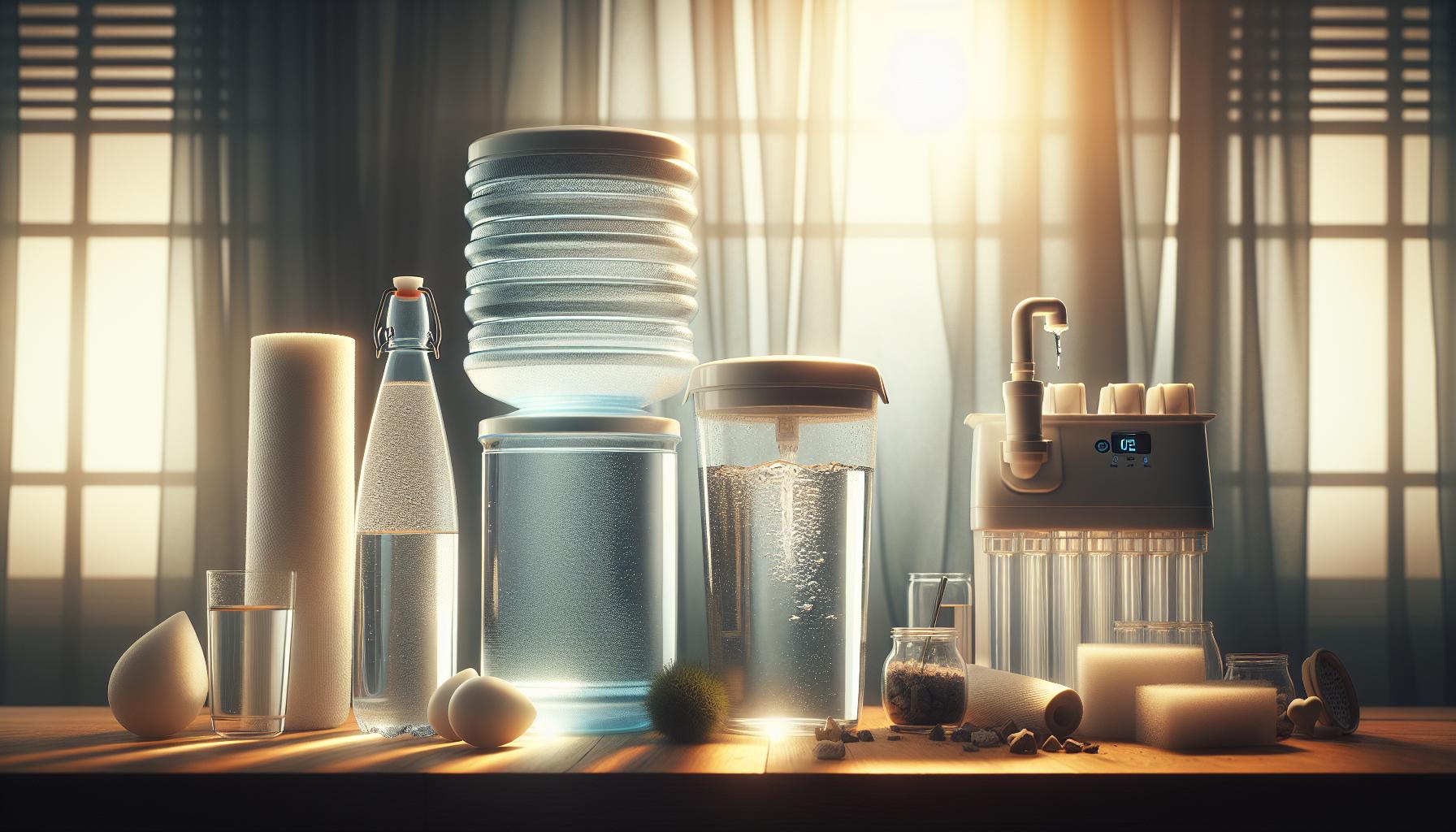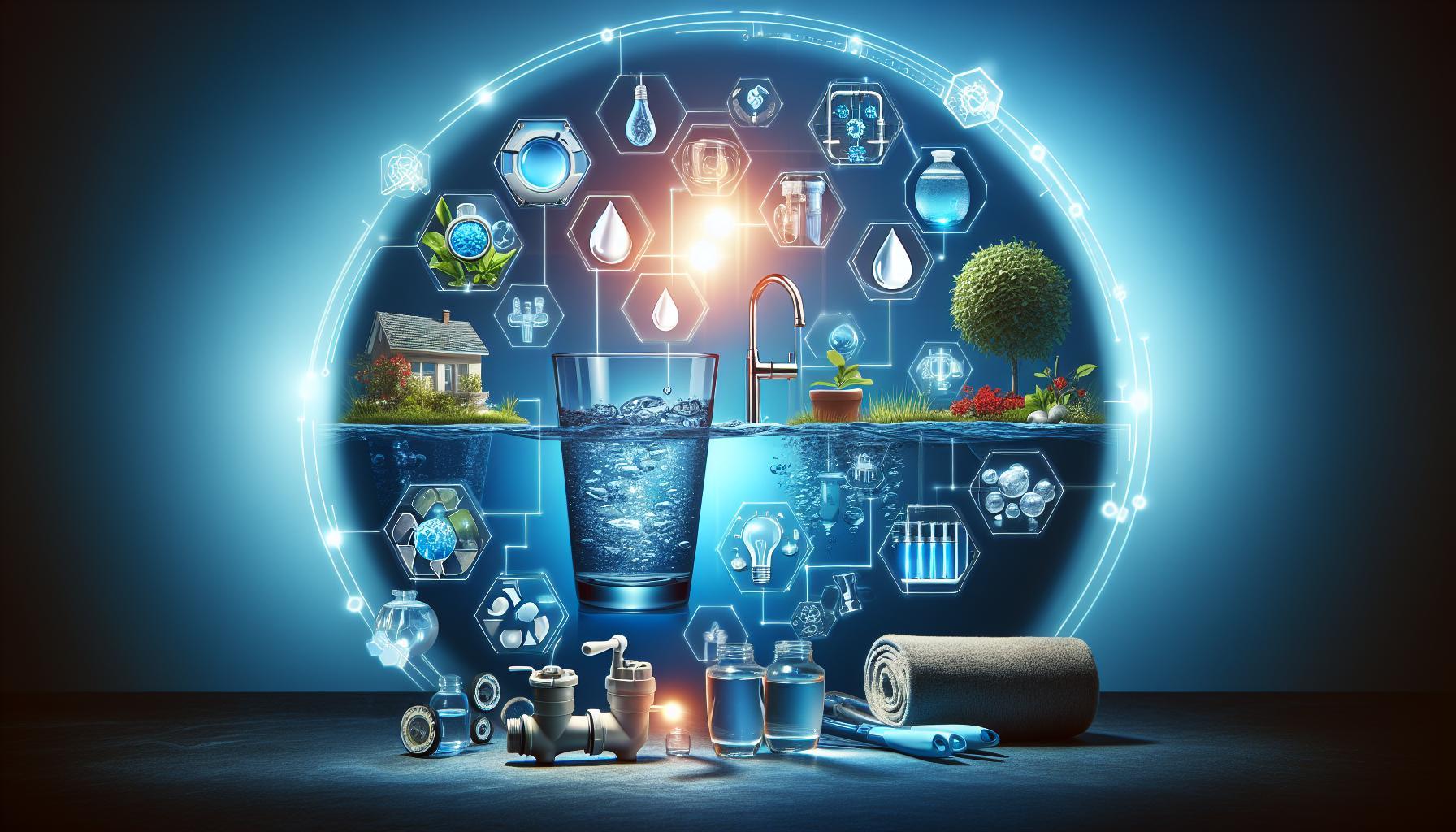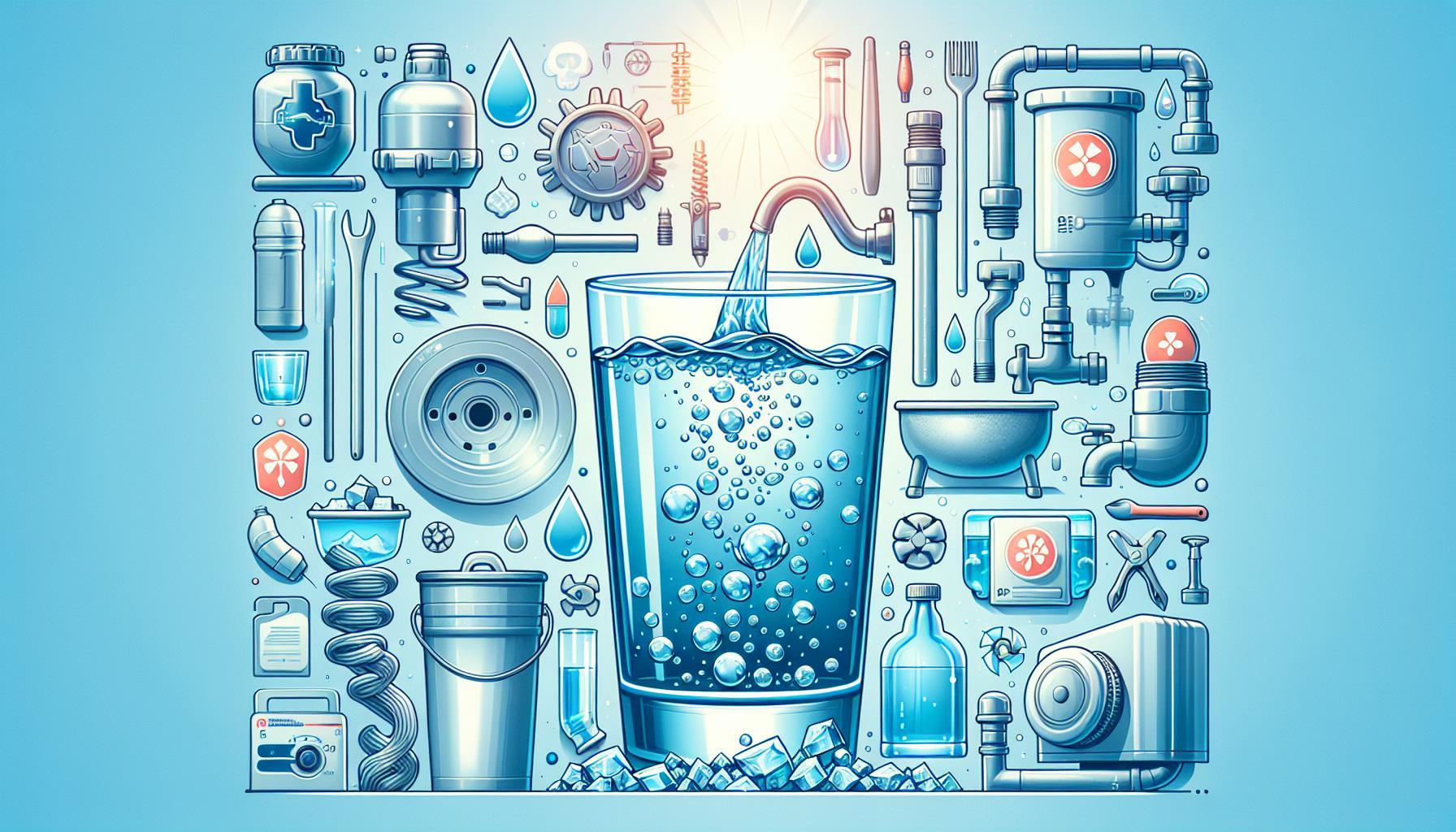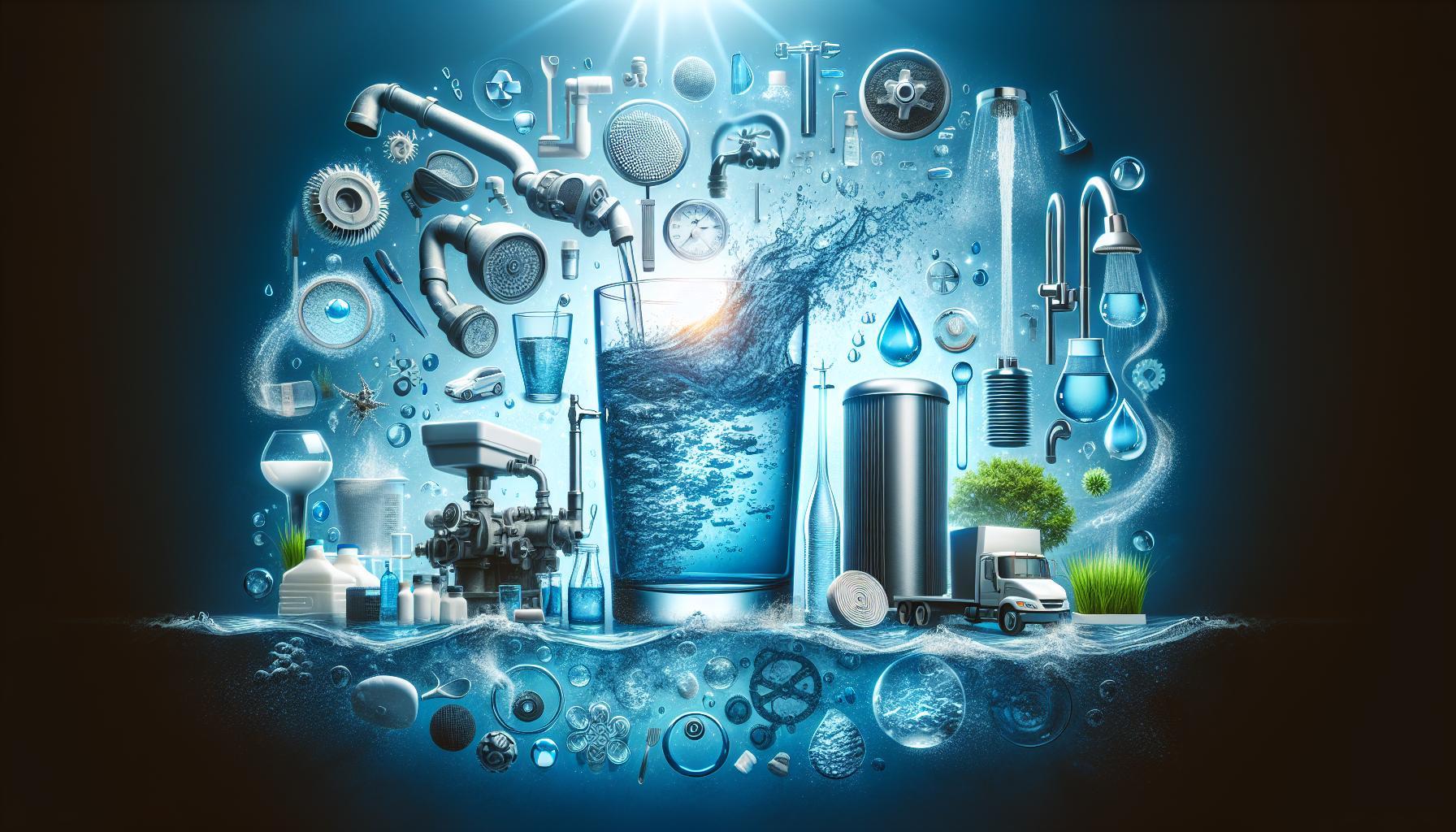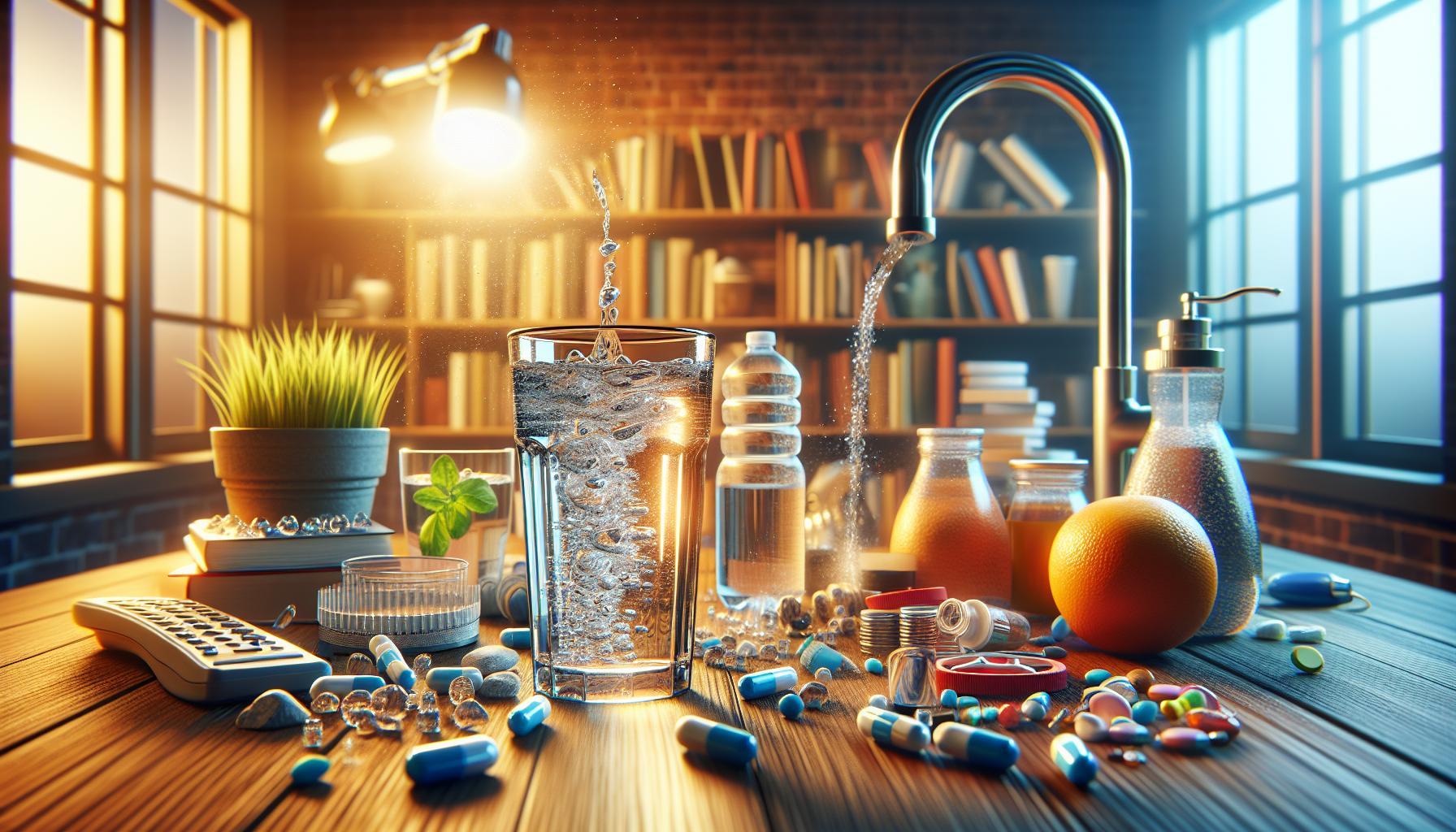As consumers become more health-conscious, the distinction between purified and filtered water often raises questions. Understanding the differences is crucial for choosing the right water for your needs. Purified water undergoes rigorous treatment to remove impurities, while filtered water typically uses various methods to improve taste and clarity. Let’s explore their unique characteristics and benefits.
Understanding Purified Water: What Does It Really Mean?
Understanding the nuances of purified water can significantly impact both your health choices and your environmental footprint. Purified water is not just any kind of water; it has undergone extensive treatment processes to ensure it is free from contaminants and impurities. This meticulous purification process can include methods such as reverse osmosis, distillation, and carbon filtration. Each of these methods plays a role in delivering water that not only meets safety standards but also often tastes better than untreated water.
What Characteristics Define Purified Water?
One of the key characteristics that define purified water is its adherence to stringent quality standards set by organizations like the Environmental Protection Agency (EPA). According to the EPA, purified water is treated to remove all pathogens, chemical contaminants, and dissolved solids. This makes it a safe choice for drinking and cooking, particularly in areas where tap water quality may be variable or unreliable [[2]]. The result is water that provides peace of mind and promotes better health outcomes.
In addition to its safety, purified water offers various benefits, such as improved taste and odor. For those who dislike the chlorine smell often associated with tap water, purified water provides a cleaner alternative. This is especially important for households with children or individuals sensitive to tastes and smells. Furthermore, by choosing purified water sources, consumers can help reduce plastic waste associated with bottled water, as many brands offer bulk purified water options that can be dispensed into reusable containers [[3]].
Practical Differences: Purified vs. Filtered Water
When discussing the differences between purified and filtered water, it is crucial to recognize that while all purified water is filtered, not all filtered water is purified. Standard filtration systems can remove certain sediments and larger particles; however, they might not address chemical contaminants or microorganisms effectively. Therefore, if you are considering which water type to use in your home, opting for purified water is a proactive step toward ensuring a higher quality of hydration.
To help visualize the differences, here’s a simple comparison:
| Characteristic | Purified Water | Filtered Water |
|---|---|---|
| Treatment Process | Extensive purification methods (e.g., reverse osmosis, distillation) | Basic filtration (e.g., activated carbon filters) |
| Contaminant Removal | Removes the majority of chemical contaminants, pathogens, and solids | Removes sediments and larger particles, but not all chemicals |
| Flavor | Generally better tasting, free from chlorine and other odors | Can vary, often retains some tastes from tap water |
Choosing purified water not only promotes wellness but also fosters environmental responsibility. By understanding the importance of water quality, you can make informed decisions that benefit both your health and the planet.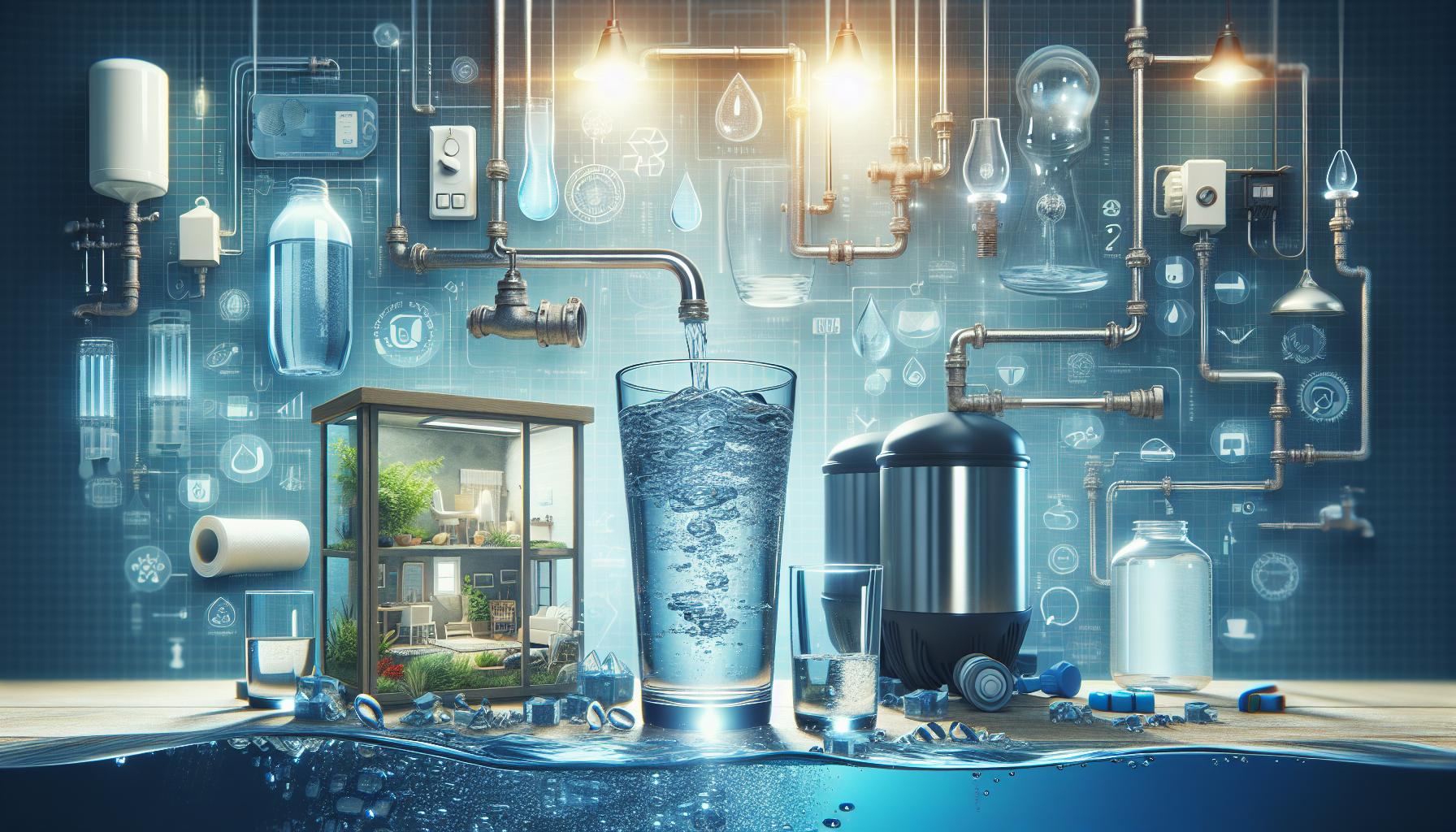
Exploring Filtration: How Does It Change Our Water?
While we often treat water as a simple resource, the processes of purification and filtration significantly transform its composition and quality, affecting both taste and safety. Understanding the nuances in these processes opens up a clearer perspective on what we are consuming. Water filtration involves various methods that remove impurities such as sediments, chlorine, and even some pathogens. With different technologies available, including activated carbon and reverse osmosis, the end result is not only water that tastes better but also one that is safer for consumption.
Filtration Techniques and Their Benefits
The effectiveness of water filters can vary based on the technology used. Here are several common filtration methods and their benefits:
- Granular Activated Carbon (GAC): This method is widely used for its ability to improve the taste and odor of water by removing chlorine and organic compounds.
- Reverse Osmosis (RO): This technique pushes water through a semi-permeable membrane, removing a broad range of contaminants including heavy metals.
- Microporous Ceramic Filters: Effective in eliminating bacteria and protozoa, making it an ideal choice for improving microbiological safety.
- Ultrafiltration: Similar to reverse osmosis but with a larger pore size, it can remove particulate matter and some larger bacteria while keeping beneficial minerals.
These techniques not only enhance the quality of drinking water but also ensure compliance with health standards, thereby helping to prevent waterborne diseases.
Understanding the Differences in Water Treatments
When parsing the differences between purified and filtered water, it’s essential to recognize that while all purified water is filtered, not all filtered water is purified. To further clarify this concept, consider the following comparisons:
| Aspect | Filtered Water | Purified Water |
|---|---|---|
| Filtration Process | Removes particulate matter, chlorine, and some contaminants. | Involves extensive filtration, including removal of dissolved minerals and heavy metals. |
| Taste | Improved taste due to chlorine and odorous compounds removal. | Very clean taste as most impurities are removed. |
| Common Methods | Activated carbon, ceramic filters. | Reverse osmosis, distillation. |
By knowing these differences, consumers can make informed decisions based on their water quality needs and personal preferences. Whether seeking out enhanced flavor or the utmost purity, understanding water treatment processes empowers individuals to take control of their hydration choices.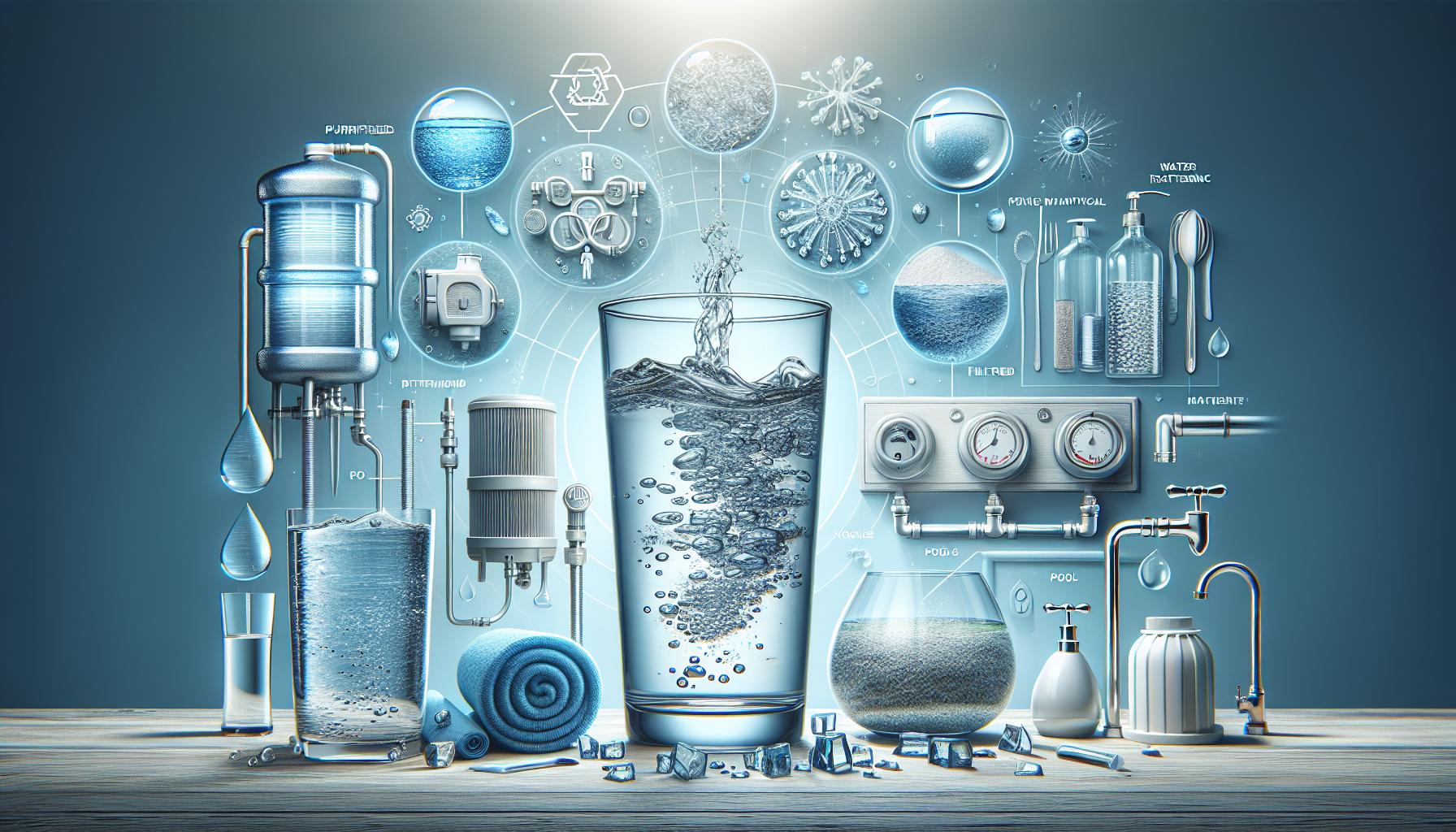
Key Differences Between Purified and Filtered Water
When it comes to ensuring the quality of what we drink, understanding the nuances between purified and filtered water can be surprisingly informative. Both terms suggest a level of cleanliness and safety, but they refer to different processes that affect the water’s chemical composition and taste. Let’s explore the key differences that set these two types of water apart, helping you make more informed choices for your hydration needs.
Purification Process
Purified water undergoes a comprehensive treatment process designed to remove impurities and contaminants. This can involve several methods, including distillation, reverse osmosis, or deionization. The outcome is water that meets stringent standards for purity, often considered ideal for those with specific health considerations. Here are some common purification methods:
- Distillation: Boiling water and collecting the steam, which leaves solid contaminants behind.
- Reverse Osmosis: Forcing water through a semipermeable membrane to eliminate dissolved solids and contaminants.
- Deionization: Removing ionized minerals and salts from water through chemical processes.
With these methods, purified water typically has fewer dissolved solids compared to regular tap water, making it a preferred option for many households.
Filtration Techniques
Filtered water, on the other hand, involves passing water through various types of filters designed to remove specific impurities. Unlike purification, which aims for high standards of purity, filtration focuses more on improving taste and odor while removing larger particulate matter. Some common filtration methods include:
- Carbon Filtration: Utilizing activated charcoal to absorb chlorine, sediments, and volatile organic compounds (VOCs).
- Mechanical Filtration: Using physical barriers to remove larger particles, dirt, and silt.
- UV Filtration: Employing ultraviolet light to eliminate bacteria and viruses without altering water taste.
While filtered water is cleaner than standard tap water, it may retain some chemicals and minerals that purification processes would remove.
Comparison Table
To further clarify the distinctions between purified and filtered water, consider the following comparison:
| Feature | Purified Water | Filtered Water |
|---|---|---|
| Definition | Water treated to remove contaminants and impurities to meet strict safety standards. | Water passed through filters to improve taste and odor, focusing on removing larger particles. |
| Common Methods | Distillation, Reverse Osmosis, Deionization. | Carbon Filtration, Mechanical Filtration, UV Filtration. |
| Mineral Content | Low; most minerals and salts are removed. | Varies; retains some natural minerals. |
| Health Considerations | Ideal for individuals with compromised immune systems. | Better for general consumption if tap water quality is poor. |
Ultimately, the choice between purified and filtered water boils down to individual needs and preferences. Understanding how each process works can empower you with the knowledge needed to select the best hydration solutions for your lifestyle. Whether you’re aiming for the absolute purity of distilled water or the taste improvement of filter options, being informed allows you to ensure you’re drinking the safest and most enjoyable water possible.
The Science Behind Water Purification Methods
Many people rely on clean water for their health and well-being, yet few understand the intricate processes that transform contaminated water into a safe and consumable resource. Water purification employs various methods to eliminate impurities, making it essential not only for personal health but also for sustaining environments and communities. In the quest to understand whether purified and filtered water are the same, it is crucial to dive into the science behind these purification methods and how they function.
The Mechanisms of Purification
Water purification encompasses a variety of strategies, each designed to remove specific contaminants. Among the common methods are:
- Boiling: This age-old technique involves heating water to kill pathogens. Boiling can destroy up to 99.9% of all living organisms present, including bacteria and viruses.
- Filtration: Utilizing materials like activated carbon or ceramic, filtration methods effectively capture unwanted solids and microorganisms, improving clarity and taste.
- Distillation: By converting water into vapor and then condensing it back into liquid, distillation not only removes biological contaminants but also eliminates minerals and some chemicals.
- Deionization: This advanced process removes dissolved salts and inorganic substances, making water particularly pure.
Each method serves a distinct purpose and may be suitable for various situations depending on the pollutants present in the source water.
Understanding Purified vs. Filtered Water
When examining the distinction between purified and filtered water, it is essential to acknowledge the specific processes involved. Purified water generally refers to H2O that has undergone extensive processing methods—such as distillation, deionization, or reverse osmosis—resulting in a product that is free from chemicals, microbes, and minerals to a high degree. In contrast, filtered water typically involves the removal of larger particles and some impurities but may still retain certain minerals and contaminants, leaving some health concerns unaddressed.
To clarify these differences, the following table summarizes key distinctions:
| Feature | Purified Water | Filtered Water |
|---|---|---|
| Processing Method | Advanced methods (distillation, deionization) | Simple filtration (activated carbon, straining) |
| Contaminant Removal | High level (microbes, chemicals) | Moderate level (larger particles) |
| Mineral Content | Low or none | Retains some minerals |
In understanding the complexities of water treatment, we can appreciate the diverse technologies that enable access to safe drinking water. Each method, whether it is categorized under purification or filtration, plays a vital role in ensuring that the water we consume meets health safety standards. Recognizing these differences is essential for making informed decisions about water consumption and its associated health impacts.
When to Choose Purified vs. Filtered Water
When you’re staring at the myriad of water brands in the store, the choice between purified and filtered water can be quite overwhelming. Understanding the nuanced differences and benefits of these two types of water can empower you to make informed decisions based on your health, lifestyle, and preferences. Purified and filtered water serve distinct purposes, and knowing when to choose one over the other can significantly impact your hydration experience.
Understanding Your Water Needs
The choice between purified and filtered water largely depends on the specific quality of your source water and your personal health goals. Purified water undergoes extensive processes such as reverse osmosis, distillation, or deionization. This makes it an excellent option if you’re concerned about potential contaminants or if you live in an area where tap water quality is questionable. For instance, if you are sensitive to heavy metals or chlorine, purified water is your best bet since it removes these impurities effectively.
On the other hand, filtered water typically comes from a tap water source that has been passed through a filtration system, which may use carbon filters or other methods to remove specific contaminants. It maintains some minerals that are beneficial for health, making it a more natural choice for daily consumption. If your home utilizes municipal water, or if you have a reliable filtration system, opting for filtered water can provide a balance of safety and taste without stripping away essential minerals.
When to Opt for Each Type
Deciding between purified and filtered water can be simplified by considering the following scenarios:
- Choose Purified Water When:
- Traveling to regions with uncertain water quality.
- Dealing with health conditions that necessitate the avoidance of trace contaminants.
- You want to ensure a clean slate that’s free from any chemicals or residues.
- Choose Filtered Water When:
- Your household has a reliable filtration system.
- You prefer water with minerals that enhance both taste and health benefits.
- You are conscious of environmental impact and prefer to avoid bottled water unless necessary.
The essence of understanding when to choose purified versus filtered water lies in assessing your unique situation. For example, in a home with a robust filtration system and good municipal water, filtered water could suffice for daily hydration. However, in a location plagued by heavy rain, flooding, or industrial runoff, the safety of purified water becomes paramount. By evaluating these factors, you can ensure that you stay well-hydrated with the best quality water suited to your needs.
Common Myths About Purified and Filtered Water
Water purity is an essential topic that deserves careful consideration, yet many misconceptions surround the processes of purification and filtration. Understanding these myths can empower you to make better choices about the water you drink. Surprisingly, even educated consumers can fall victim to these misunderstandings that ultimately influence their hydration habits and health.
Myth 1: All Purified Water is Bottled Water
Many people assume that purified water is synonymous with bottled water. This is inaccurate. While bottled water can be purified, there are various methods to produce purified water, including home filtration systems and reverse osmosis. These methods are often more environmentally friendly than single-use plastic bottles. Additionally, bottled water can come from sources that are not always filtered or purified, which can lead to variable quality.
Myth 2: Filtered Water is Always Clean Water
There’s a common belief that filtered water is automatically free from contaminants. However, the effectiveness of filtration depends on the specific type of filter used and the contaminants it is designed to remove. For instance, a simple carbon filter may reduce chlorine taste but does little for heavy metals or bacteria. Always check the specifications of your water filter to understand what it can and cannot do. This awareness can be crucial for your health.
Myth 3: Purified Water is Devoid of Essential Minerals
A misconception persists that all purified water strips away essential minerals, making it less healthy to consume. While some purification methods do remove minerals, others, like mineral filtration, actually retain valuable nutrients. Moreover, the human body derives necessary minerals from a variety of dietary sources, and not solely from water. It is beneficial to consider your overall diet when assessing mineral intake rather than relying solely on drinking water.
Understanding the Differences
To clarify these myths and approach water safety with an informed perspective, consider the following comparison table outlining key distinctions between purified and filtered water:
| Characteristic | Purified Water | Filtered Water |
|---|---|---|
| Definition | Water treated to remove impurities and contaminants | Water that has undergone a filtering process to remove specific particles |
| Methods | Reverse osmosis, distillation, carbon filtration | Carbon filters, reverse osmosis, UV treatment |
| Mineral Content | Can vary, some methods remove minerals | Generally retains minerals unless specified otherwise |
| Source | Municipal, well, or other sources | Can come from any water source, depending on the filter used |
By dispelling these myths, you can better navigate the choices surrounding purified and filtered water. Understanding that not all sources are created equal will empower you to select the water option that best meets your needs, ensuring both hydration and health are prioritized.
The Health Benefits of Purified and Filtered Water
Drinking clean water is essential for maintaining optimal health, yet many people overlook the significant differences between purified and filtered water. Understanding these distinctions can empower you to make informed choices about your hydration. Purified water undergoes stringent processes to remove contaminants, offering a clear advantage in areas where tap water may be compromised. In fact, studies indicate that purified water can effectively eliminate harmful substances, leading to improved health outcomes.
Key Health Benefits
The advantages of incorporating purified and filtered water into your daily routine are numerous:
- Enhanced Hydration: Drinking purified water ensures that your body is adequately hydrated, which is vital for overall health.
- Improved Skin Health: Pure water can contribute to clearer skin by flushing out toxins and promoting a more radiant complexion.
- Boosted Metabolism: Adequate hydration supports metabolic processes, aiding in weight management and energy levels.
- Detoxification: Regular consumption of cleaned water helps your body remove harmful chemicals and promotes liver and kidney health.
With the purification process targeting over 90 contaminants as outlined by the US Environmental Protection Agency, it is no wonder that daily consumption of purified water is recommended, particularly in regions with questionable water quality [[2]].
Making the Right Choice
To choose the right type of water for your health needs, it is important to understand the treatment methods involved. Purified water is typically produced through processes such as reverse osmosis or distillation, while filtered water generally refers to tap water that has undergone basic filtration, often leaving some minerals intact.
| Characteristic | Purified Water | Filtered Water |
|---|---|---|
| Contaminant Removal | Extensive, including heavy metals and chemicals | Basic filtration, may leave some contaminants |
| Mineral Content | May be low, depending on purification process | Typically retains some minerals |
| Health Benefits | High; supports hydration and detoxification | Moderate; good for everyday hydration |
When pondering the question, “Is purified and filtered water the same?” it is crucial to recognize that while both serve the essential purpose of hydration, they offer different levels of purification and health benefits. By selecting the appropriate type of water based on your lifestyle and health requirements, you can enhance your well-being significantly.
Making Informed Choices: What’s Best for Your Household?
Choosing the right water for your household can be a transformative decision that impacts health, hydration, and environmental sustainability. With so many options available, understanding the nuances between purified and filtered water is critical for making informed choices. While both processes aim to provide cleaner drinking water, they have distinct differences that can affect taste, mineral content, and safety.
Understanding Your Water Needs
When contemplating whether purified or filtered water is best for your household, it’s essential to first assess your specific water needs. Consider the following factors:
- Health Concerns: If there are health issues or sensitivities within your household, purified water, which removes a broader range of contaminants, might be the better choice.
- Taste Preferences: Some individuals may prefer the taste of filtered water, which can retain certain minerals beneficial for flavor while removing chlorine and other unwanted substances.
- Daily Usage: Reflect on how much water you typically consume. If you are a heavy user, long-term solutions like reverse osmosis filtration systems may prove more economical than purchasing bottled pure water.
Comparative Analysis of Water Sources
Here’s a concise comparison of purified and filtered water to help clarify which option might be best for your home.
| Aspect | Purified Water | Filtered Water |
|---|---|---|
| Definition | Water that has been treated to remove impurities, including contaminants and minerals. | Water that has gone through filtration to remove specific particles and chemicals. |
| Common Methods | Reverse osmosis, distillation, and deionization. | Activated carbon filters, ceramic filters, and UV filters. |
| Mineral Content | Very low, as most minerals are stripped away. | Contains some natural minerals depending on the filter type used. |
| Cost | Generally higher due to the purification process. | More affordable, especially with home filtration systems. |
Making the Right Choice for Your Family
To determine the best option for your family, consider conducting simple water tests for your source, which can provide a clearer picture of present contaminants. If your tap water contains high levels of lead or other harmful substances, opting for purified water could be essential. Alternatively, if your concerns center around taste and minor impurities, a good-quality filtration system may fulfill your needs perfectly.
In conclusion, understanding the differences between purified and filtered water will empower you to make choices that align with your household’s health and lifestyle. The knowledge gleaned from discerning between these two types of water can not only enhance your family’s drinking water quality but also contribute to making responsible and eco-friendly water consumption choices.
Frequently Asked Questions
What is the difference between purified water and filtered water?
Purified water has undergone a rigorous purification process, removing impurities and contaminants, while filtered water simply means water that has been passed through a filter to reduce certain substances.
Purification typically involves methods like distillation, reverse osmosis, or deionization, making it highly refined. In contrast, filtering can vary in effectiveness depending on the type of filter used, such as activated carbon or ceramic.
Is purified and filtered water the same? Know the difference.
No, purified and filtered water are not the same. Purified water is treated to remove all contaminants, while filtered water may still contain some impurities depending on the filter.
Understanding these differences can help you make informed decisions about drinking water. If you are concerned about contaminants in your water, consider opting for purified water for the highest level of safety and quality.
How is purified water made?
Purified water is made through several methods, including reverse osmosis, distillation, and deionization—each effectively removing impurities.
For instance, reverse osmosis uses a membrane to filter out contaminants, while distillation involves boiling water and condensing the steam back into liquid. These processes ensure that purified water is safe and clean for consumption.
Can I drink filtered water safely?
Yes, you can drink filtered water safely, but its safety depends on the quality of the filtration system used.
If using a high-quality filter that meets your water quality needs, filtered water can be an excellent option. Always check for certifications to ensure your filter effectively removes contaminants that may be present in your tap water.
Why does purified water taste different from filtered water?
Purified water often tastes different from filtered water due to the removal of minerals and impurities.
Many people find that the taste of purified water is crisper because it lacks any residual flavors from contaminants. In contrast, filtered water may retain some of the natural minerals, which can affect its flavor profile.
Where can I buy purified and filtered water?
You can buy purified and filtered water at grocery stores, online retailers, or through delivery services.
Many brands offer bottled purified water, while filters are available in home goods stores and online. Consider looking into subscription services that provide regular delivery of high-quality water to your home.
Do I need a water filter if I use purified water?
If you are using bottled purified water, you typically do not need an additional water filter.
However, if your primary water source is tap water, a filter can be beneficial. It can further reduce any potential contaminants and improve taste, ensuring your drinking water is as safe as possible.
Wrapping Up
In conclusion, understanding the differences between purified and filtered water can help you make informed choices about your hydration needs. Purified water undergoes a rigorous process, often involving techniques like reverse osmosis or distillation, to remove contaminants and ensure purity. On the other hand, filtered water utilizes various filtration methods to enhance taste and reduce specific impurities without necessarily removing all minerals. Each type of water has its unique benefits, catering to different preferences and health considerations.
We encourage you to dive deeper into the fascinating world of water purification methods and find the best option for your daily life. Whether you’re looking for better taste, improved safety, or specific health benefits, having the right information empowers you to choose confidently. Explore further and take charge of your hydration journey today!

